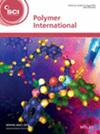Anastasiia Chebotar, Bohdan Domnich, Yurij Panchenko, Volodymyr Donchak, Yurij Stetsyshyn, Andriy Voronov
求助PDF
{"title":"Thermal behavior of polymers and copolymers based on plant oils with differing saturated and monounsaturated content","authors":"Anastasiia Chebotar, Bohdan Domnich, Yurij Panchenko, Volodymyr Donchak, Yurij Stetsyshyn, Andriy Voronov","doi":"10.1002/pi.6717","DOIUrl":null,"url":null,"abstract":"<p>Plant oil-based acrylic monomers from hydrogenated sunflower (HFM), palm (PMM) and castor (CSM) oils were polymerized to investigate the effect of chemical composition on polymer phase transitions at temperatures relevant to physiological range. While HFM and PMM possess a highly differing content of saturated palmitic and stearic acids combined with unsaturated fatty acids, CSM contains primarily fragments based on monounsaturated ricinoleic hydroxy acid (up to 90%). Differential scanning calorimetry (DSC) measurements indicate that polymers from PMM and HFM are both semicrystalline (with <i>T</i><sub>m</sub> = −6 and −13 °C, respectively), while poly(CSM) appears to be amorphous (<i>T</i><sub>g</sub> = −49 °C). Considering the similarity in polymers' molar mass (<i>M</i><sub>n</sub> = 16 000–20 000 g mol<sup>−1</sup>), the observed thermal transitions can be explained by the formation of ordered morphological domains due to the presence of saturated palmitic and stearic acid fractions in poly(PMM) and poly(HFM). For copolymers of CSM, PMM and HFM (80 wt% of monomer feed) with styrene, DSC data show two transitions corresponding to the mobility of long alkyl fatty acid side fragments and the macromolecular backbone. For copolymers of PMM and HFM, comparable values (−52.8 and −55.5 °C, respectively) were obtained, while the second transition for poly(CSM-<i>co</i>-styrene) appears at 35 °C. We attribute this higher value to the presence of hydroxyl groups in ricinoleic acid fragments of CSM serving as additional chain transfer sites and the formation of macromolecular fractions enriched with polystyrene fragments. We expect that the temperature transitions obtained can be relevant to the future use of these polymers for biomedical applications, including the synthesis of polymer brushes. © 2024 Society of Chemical Industry.</p>","PeriodicalId":20404,"journal":{"name":"Polymer International","volume":"74 3","pages":"255-263"},"PeriodicalIF":3.6000,"publicationDate":"2024-11-14","publicationTypes":"Journal Article","fieldsOfStudy":null,"isOpenAccess":false,"openAccessPdf":"","citationCount":"0","resultStr":null,"platform":"Semanticscholar","paperid":null,"PeriodicalName":"Polymer International","FirstCategoryId":"92","ListUrlMain":"https://scijournals.onlinelibrary.wiley.com/doi/10.1002/pi.6717","RegionNum":4,"RegionCategory":"化学","ArticlePicture":[],"TitleCN":null,"AbstractTextCN":null,"PMCID":null,"EPubDate":"","PubModel":"","JCR":"Q2","JCRName":"POLYMER SCIENCE","Score":null,"Total":0}
引用次数: 0
引用
批量引用
Abstract
Plant oil-based acrylic monomers from hydrogenated sunflower (HFM), palm (PMM) and castor (CSM) oils were polymerized to investigate the effect of chemical composition on polymer phase transitions at temperatures relevant to physiological range. While HFM and PMM possess a highly differing content of saturated palmitic and stearic acids combined with unsaturated fatty acids, CSM contains primarily fragments based on monounsaturated ricinoleic hydroxy acid (up to 90%). Differential scanning calorimetry (DSC) measurements indicate that polymers from PMM and HFM are both semicrystalline (with T m = −6 and −13 °C, respectively), while poly(CSM) appears to be amorphous (T g = −49 °C). Considering the similarity in polymers' molar mass (M n = 16 000–20 000 g mol−1 ), the observed thermal transitions can be explained by the formation of ordered morphological domains due to the presence of saturated palmitic and stearic acid fractions in poly(PMM) and poly(HFM). For copolymers of CSM, PMM and HFM (80 wt% of monomer feed) with styrene, DSC data show two transitions corresponding to the mobility of long alkyl fatty acid side fragments and the macromolecular backbone. For copolymers of PMM and HFM, comparable values (−52.8 and −55.5 °C, respectively) were obtained, while the second transition for poly(CSM-co -styrene) appears at 35 °C. We attribute this higher value to the presence of hydroxyl groups in ricinoleic acid fragments of CSM serving as additional chain transfer sites and the formation of macromolecular fractions enriched with polystyrene fragments. We expect that the temperature transitions obtained can be relevant to the future use of these polymers for biomedical applications, including the synthesis of polymer brushes. © 2024 Society of Chemical Industry.
基于不同饱和和单不饱和含量植物油的聚合物和共聚物的热行为
以氢化向日葵油(HFM)、棕榈油(PMM)和蓖麻油(CSM)为原料聚合植物油基丙烯酸单体,研究化学成分对聚合物在生理温度范围内相变的影响。HFM和PMM的饱和棕榈酸和硬脂酸以及不饱和脂肪酸的含量差异很大,而CSM主要含有基于单不饱和蓖麻油酸羟基酸的片段(高达90%)。差示扫描量热法(DSC)测量表明,PMM和HFM的聚合物都是半结晶(Tm分别为- 6和- 13°C),而聚(CSM)似乎是无定形的(Tg = - 49°C)。考虑到聚合物的摩尔质量(Mn = 16 000 - 20 000 g mol−1)的相似性,观察到的热转变可以用聚酰亚胺(PMM)和聚酰亚胺(HFM)中饱和棕榈酸和硬脂酸组分的存在形成有序的形态域来解释。对于CSM, PMM和HFM(占单体进料的80%)与苯乙烯的共聚物,DSC数据显示了与长烷基脂肪酸侧片段和大分子主链的迁移率相对应的两个转变。对于PMM和HFM的共聚物,得到了相似的值(分别为- 52.8和- 55.5°C),而聚(csm -co-苯乙烯)的第二次过渡出现在35°C。我们将这一较高的值归因于CSM的蓖麻油酸片段中羟基的存在,作为附加的链转移位点,并形成了富含聚苯乙烯片段的大分子组分。我们期望获得的温度转变可以与这些聚合物在生物医学应用中的未来使用相关,包括聚合物刷子的合成。©2024化学工业学会。
本文章由计算机程序翻译,如有差异,请以英文原文为准。



 求助内容:
求助内容: 应助结果提醒方式:
应助结果提醒方式:


